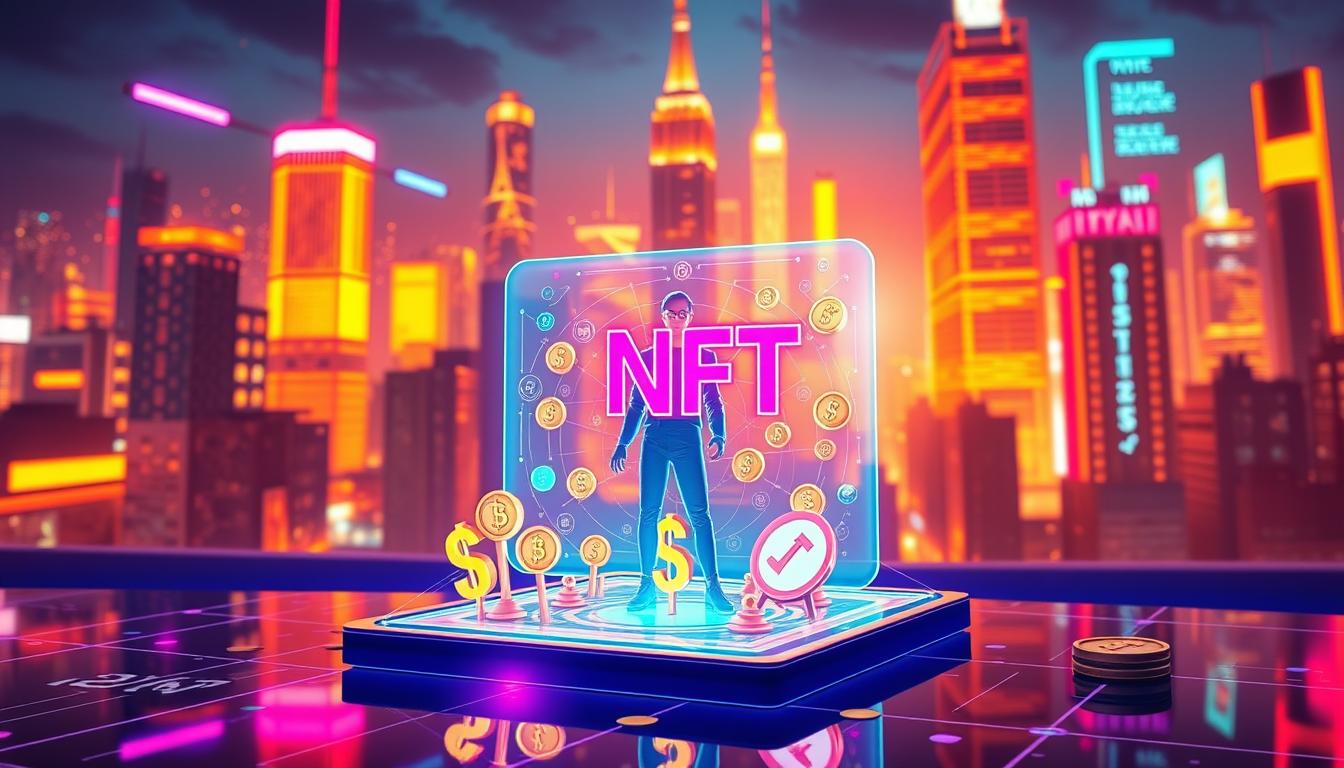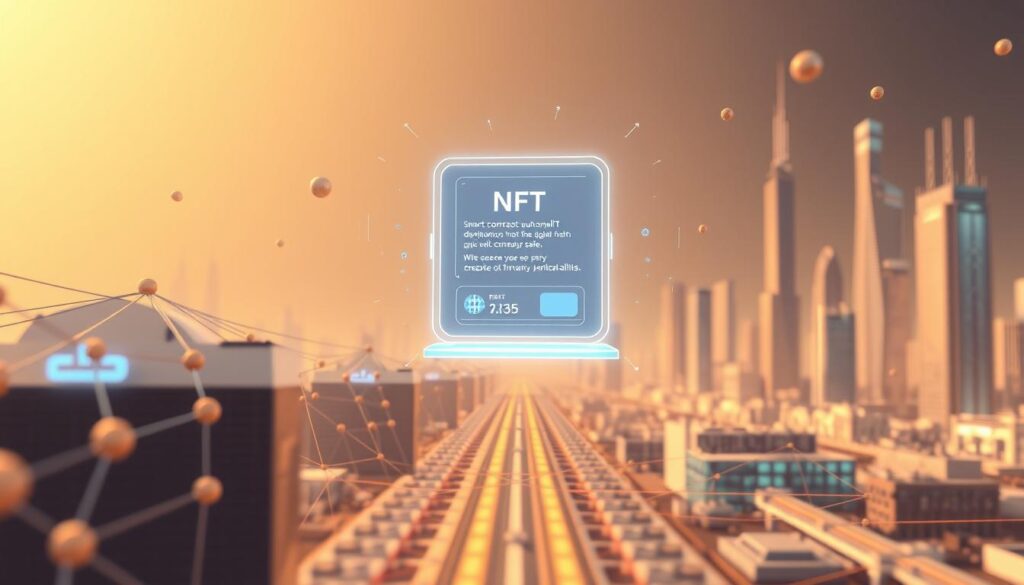Now Reading: Maximise Earnings with NFT Royalties Creator Secondary Sales
- 01
Maximise Earnings with NFT Royalties Creator Secondary Sales
Maximise Earnings with NFT Royalties Creator Secondary Sales

The digital landscape is revolutionising how artists earn from their work. Unlike traditional models, a new system allows for continuous income long after the initial sale. This represents a fundamental shift towards sustainable revenue for digital asset producers.
This innovative approach ensures that originators receive a percentage every time their work is resold. It moves beyond the single payment structure that has long defined creative industries. The mechanism is automated, powered by blockchain technology and smart contracts.
This automation eliminates the need for manual tracking or third-party involvement. It provides a reliable, ongoing revenue stream. For musicians, artists, and brands, this means benefiting directly from the increasing value of their digital creations.
Understanding and effectively implementing this system is crucial for maximising its potential. This guide will explore how it functions and strategies for optimisation. Using a specialised analytics platform for investment tracking can be a key part of this process.
Key Takeaways
- This model provides a continuous income stream from digital works, unlike traditional one-off payments.
- Payments are automatically triggered each time an asset is resold on subsequent markets.
- Blockchain technology facilitates this process, removing the need for intermediaries.
- It offers a groundbreaking opportunity for long-term, sustainable monetisation.
- This system empowers originators by allowing them to benefit from the lasting value of their assets.
- Proper implementation and management are essential for maximising financial returns.
Understanding NFT Royalties and Their Value
The ability to earn from a digital piece long after its initial transaction is powered by a unique protocol. This system provides a foundational shift towards sustainable income for artists and brands.
What are NFT royalties?
These are automated payouts given to the originator each time their digital asset is sold or resold on a marketplace. They represent a small fraction of the sale price.
A typical percentage for these payouts falls between 5% and 10%. This is permanently encoded into the asset’s smart contract at the time of creation.
The blockchain tracks every transaction. When a resale occurs, the desired percentage is automatically transferred to the originator. This process requires no manual intervention.
It is crucial to note that not all non-fungible tokens (NFTs) include this feature. The originator must deliberately set the terms within the smart contract.
Benefits for creators and collectors
For artists and musicians, this system offers perpetual passive income. It encourages the production of high-quality work with the assurance of ongoing compensation.
Collectors also benefit significantly. The system makes it easy to verify the authenticity and original maker of a digital asset. This reduces concerns about forgeries devaluing investments.
Furthermore, originators retain full copyright ownership. They can even sell these ownership rights, with subsequent payments going to the new rights holder.
How NFT Royalties Work on the Blockchain
At the core of this new earning model lies a powerful piece of code known as a smart contract. This digital agreement is programmed to execute actions automatically when specific conditions are met.
For digital assets, the key condition is a successful transfer of ownership. When this happens, the contract triggers a payment.

Role of Smart Contracts in Automating Payments
These contracts completely remove the need for middlemen. There is no manual invoicing or chasing payments.
The originator sets the terms, such as a percentage of the sale price or a flat fee. This is embedded into the asset’s code from the start.
Most platforms allow artists to choose a percentage, typically between 5% and 10%. The contract then enforces this rule with every subsequent transaction on that blockchain.
Generating Ongoing Revenue via Secondary Sales
This automation creates a perpetual revenue stream. Every time the digital item changes hands, the original maker receives compensation.
The system ensures a direct connection between the artist and the appreciating value of their work. It’s a fundamental shift from traditional one-off payments.
However, it’s important to understand that the smart contract’s power is tied to the blockchain where the asset was created. As this detailed analysis of how NFT royalties explains, enforcement can vary across different platforms.
| Aspect | Traditional System | Blockchain-Based System |
|---|---|---|
| Payment Trigger | Manual reporting & audits | Automatic on transaction |
| Intermediaries | Required (publishers, agencies) | Eliminated |
| Payment Speed | Often delayed (months) | Near-instantaneous |
| Enforcement | Legal contracts | Code-based smart contracts |
This table highlights the efficiency gains of the automated approach. The process is faster, more transparent, and puts control directly in the hands of the originator.
NFT royalties creator secondary sales: A Detailed Look
The configuration of ongoing compensation terms represents a critical decision point for digital asset originators. This choice directly influences long-term revenue potential and market participation.

Setting Royalty Percentages Effectively
Most digital marketplaces allow artists to select their preferred compensation rate during the minting process. The typical range falls between 5% and 10% of each transaction value.
Originators have complete flexibility in determining their financial terms. They can choose between a percentage-based model or a fixed fee structure. The percentage option scales with the asset’s appreciating value.
Successful projects like the Bored Ape collection demonstrate that lower rates can work effectively with high trading volume. Yuga Labs receives 2.5% from each transaction in their popular collection.
Finding the right balance is essential. Too high a percentage may discourage market activity, while too low reduces potential earnings. The chosen terms become permanently encoded in the smart contract.
Different platforms may enforce these agreements differently. Understanding each marketplace’s policies ensures proper implementation of your financial strategy.
Implementing Smart Contracts for Automatic Payments
Implementing automatic payment systems requires careful technical planning from the outset. The foundation lies in selecting the right technological infrastructure and programming precise financial terms.

This process begins with choosing where to build your digital assets. The technical decisions made here will determine how reliably your payment system functions.
Choosing the right blockchain platform
Different networks offer varying levels of support for automated payment enforcement. Ethereum remains the most established choice, but newer options like Aptos provide advantages in speed and cost.
Artists must consider transaction fees, marketplace support, and technical capabilities. An asset created on one network might not carry its payment terms if moved to another platform.
This interoperability challenge can result in lost compensation. The industry is working toward standardisation solutions across different technological environments.
Customising royalty conditions with smart contracts
These digital agreements allow for sophisticated payment structures beyond simple percentages. Programmers can build in multiple beneficiaries, time-based conditions, or complex arrangements.
Proper implementation requires technical understanding or developer collaboration. The contract code must accurately reflect the artist’s intentions and execute reliably.
| Platform Feature | Ethereum | Aptos | Other Networks |
|---|---|---|---|
| Transaction Speed | Moderate | High | Variable |
| Gas Fees | Typically higher | Typically lower | Network-dependent |
| Royalty Enforcement | Well-established | Growing support | Varies significantly |
This comparison highlights why platform selection matters for payment reliability. The right choice ensures your financial terms function as intended across marketplaces.
Setting Up Your NFT Marketplace for Secondary Sales
Platform selection now represents one of the most critical business decisions for digital artists. The landscape has become fragmented with varying approaches to compensation models.

Selecting Platforms That Support Automated Compensation
Recent shifts in digital trading environments have created new challenges. Some platforms have moved away from mandatory payment systems to attract more traders.
MagicEden, a major Solana marketplace, made compensation optional in September 2022. LooksRare implemented a checkbox system allowing buyer choice. However, they distribute 25% of transaction fees to originators.
Other platforms like Yawww and SudoAMM launched without support for automated payments. X2Y2 and Solanart also prioritised collector appeal over originator compensation.
OpenSea continues to support mandatory payment enforcement for new collections. They believe artists should control their financial terms.
This creates important business considerations for content producers. Platforms with optional payments might see higher trading volume. However, enforced payment systems provide more predictable income streams.
Artists should evaluate marketplace features beyond payment support. Consider user base size, transaction costs, and technical capabilities. Choosing the right platform ensures maximum earnings from resales.
Overcoming Technical and Legal Challenges in NFT Royalties
The global nature of digital asset trading presents unique obstacles for consistent royalty enforcement. While smart contracts automate payments effectively within their native environment, they face limitations when assets cross technological boundaries.
Different blockchain networks often use incompatible standards for digital assets. This creates interoperability issues that can disrupt payment systems.
Navigating blockchain interoperability issues
When digital items move between platforms, their embedded payment terms may not transfer automatically. An asset created on one network might lose its compensation mechanism on another.
This technical gap can result in lost payments for originators. The industry is developing solutions to bridge these compatibility challenges.
Cross-chain protocols and standardised frameworks are emerging to maintain payment consistency. These tools help preserve financial terms across different technological ecosystems.
| Solution Type | Implementation Method | Effectiveness Level |
|---|---|---|
| Cross-Chain Bridges | Protocol translation between networks | Moderate to High |
| Universal Standards | Industry-wide technical specifications | Growing adoption |
| Platform Agreements | Marketplace cooperation on enforcement | Variable by platform |
Understanding intellectual property and legal frameworks
Digital assets operate across international borders with varying legal systems. Intellectual property laws differ significantly between jurisdictions.
Some countries may not recognise smart contract agreements as legally binding. This creates enforcement challenges for payment terms.
Blockchain anonymity complicates dispute resolution when payment issues arise. Identifying parties for legal action can be difficult.
Content producers should seek legal advice to ensure their agreements comply with relevant laws. Proper documentation helps protect ownership rights across different legal environments.
Strategies to Maximise Earnings from NFT Royalties
To fully capitalise on the potential of automated digital compensation, a strategic approach is essential. This involves not just setting terms but actively fostering an environment where your work retains and grows in value over time.
Leveraging Continuous Revenue from Secondary Sales
The key to sustained income lies in encouraging a vibrant resale market. Artists can achieve this by building strong, engaged communities around their work.
Offering ongoing utility, like exclusive content or membership perks tied to the digital asset, gives collectors a reason to hold and trade. This sustained interest drives transaction volume.
The automated nature of smart contracts means you earn passively with each trade. This allows you to focus on new projects while previous work continues to generate revenue.
Collaborating for Fair Compensation
Businesses are increasingly partnering with digital artists to tap into their audiences. These collaborations can be structured to provide fair compensation that benefits everyone.
Innovative models can reward early supporters. For example, a smart contract can be programmed to share a small percentage with the first buyer when a resale occurs.
This shared success model incentivises promotion and helps content go viral. It strengthens the entire digital ecosystem by aligning the interests of makers, collectors, and platforms.
| Strategy Focus | Key Action | Potential Outcome |
|---|---|---|
| Community & Utility | Build engaged followers and add lasting value to assets. | Increased trading volume and asset longevity. |
| Collaborative Models | Partner with businesses and reward early collectors. | Expanded reach, shared success, and a healthier market. |
| Platform Selection | Choose marketplaces that enforce payment terms reliably. | Predictable and consistent revenue stream from resales. |
Future Trends in NFT Royalty Models
The evolution of digital asset compensation is entering an exciting new phase. Innovative approaches are emerging to balance payment enforcement with platform functionality.
These new systems aim to create fairer ecosystems for all participants. They move beyond simple percentage-based models toward more sophisticated structures.
Innovative Approaches Such as Staking Mechanisms
New compensation designs address current limitations through creative solutions. Staking mechanisms represent one promising development.
This approach expands existing allowlist systems with financial commitments. Platforms can permissionlessly join allowlists by staking resources as collateral.
If a marketplace misbehaves, creators can remove them and slash their stake. This creates strong incentives for proper payment enforcement.
The right of reclaim concept offers another innovative solution. It refines digital ownership by separating asset holding from title ownership.
The last wallet to properly compensate the artist maintains special rights. This encourages payment without restricting how assets can be used.
| Model Type | Enforcement Method | Composability Level | Adoption Status |
|---|---|---|---|
| Staking Mechanism | Financial collateral system | High | Experimental |
| Right of Reclaim | Incentive-based ownership rights | Full | Concept stage |
| Dynamic Pricing | Algorithmic adjustment | Medium | Early development |
These models represent significant advances in compensation technology. They aim to make royalty respect the economically rational choice.
As the ecosystem matures, we’ll see more experimentation with time-based conditions and community governance. The future looks bright for sustainable digital asset compensation.
Conclusion
Mastering automated compensation systems unlocks unprecedented opportunities for long-term revenue generation. This approach fundamentally transforms how digital assets create sustainable value for their originators. The continuous income model incentivises high-quality content production across creative industries.
While technical and legal challenges require careful navigation, the potential rewards justify the investment. Strategic platform selection and smart contract implementation are crucial steps in this process. Businesses that embrace these systems gain competitive advantages in attracting top talent.
The future promises even more sophisticated compensation models. As technology evolves, so too will the mechanisms for fair ownership recognition. This represents a lasting shift toward equitable digital economies.
FAQ
What exactly are NFT royalties?
These are automatic payments sent to an artist or developer each time their digital asset is resold on a marketplace. The percentage is set by the content owner and encoded directly into the token’s smart contract on the blockchain.
How do smart contracts handle these payments?
A smart contract is a self-executing programme living on the blockchain. It contains the terms of the agreement, including the royalty percentage. When a secondary transaction occurs, the contract automatically diverts the specified portion of the sale price to the original creator’s wallet.
What is a typical royalty percentage?
While percentages can vary, a common range is between 5% and 10% of the resale value. The specific rate is decided by the artist or business when they first mint the token. It is crucial to select a figure that ensures fair compensation without discouraging future trading activity.
Do all marketplaces enforce these payments?
A> Not all platforms honour these programmed terms. Some major marketplaces, like OpenSea and Magic Eden, have systems in place to support automated royalty payments. However, it is essential to research a platform’s policy before listing your collection to ensure your intellectual property rights are protected.
Can I change the royalty percentage after the token is minted?
Generally, the terms written into a smart contract at the time of creation are permanent and cannot be altered. This immutability is a core feature of blockchain technology, providing certainty for both the creator and collectors regarding future transactions.
What legal frameworks govern these earnings?
The legal landscape for digital property and resale rights is still developing. While the smart contract handles the technical enforcement, the underlying intellectual property ownership and the legality of the payment model can depend on regional laws. Consulting with a legal professional familiar with digital assets is advisable.















